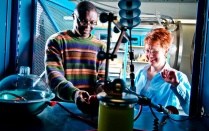
Miao Yu
PhD
Research Topics
nanostructures; zeolites; membranes; separations
Research interests
Sustainable energy, environment, water and food, in a large extent, depends on acquiring/capturing/utilizing small molecules, such as H2O, NH3, CO2, CH4, ethanol and liquid hydrocarbons, etc. Traditional technologies on harvesting or producing these molecules are either energy intensive or restricted by their large size. Precisely designing stable, molecular-scale pores for sieving these valuable molecules, either from the final product or during their production processes, could be an effective way of acquiring these molecules using compact and well-engineered systems. Considering the small sizes (0.26~1.0 nm) of these molecules and tiny size difference from their contaminants/byproducts, it is a grand challenge to design these molecular-scale pores, especially using stable and desired materials.
My research interest is focused on rationally designing and fabricating nanoporous materials/structures for precisely distinguishing molecules by size/shape differences, characterizing and understanding the nanostructures, and applying them for separation and for catalysis. My long-term professional goal is to commercialize more than two technologies, which will generate profound impact on energy, environment, water and food, via design of novel and scalable functional nanoporous materials/structures guided by deep fundamental understanding of materials synthesis/growth mechanisms and structure/property relationship.
My research group has made significant breakthrough and unique contribution on fabricating novel nanoporous materials/structures and reported our work in top journals and won federal awards to support our work. We are the first group reporting the thinnest graphene oxide (GO) membranes for effective gas separation, and this revolutionary work was published in Science in 2012. Recently, we discovered a unique Na+-gated nanochannel that allows fast water permeation but blocks gas molecules (as small as H2) even under harsh conditions; drastically increased CO2 conversion to methanol in CO2 hydrogeneration was achieved via in-situ, fast water removal by Na+-gated nanochannels. This result was reported in Science in 2020. Currently, active research projects in my group include i) novel sorbents for CO2 capture from flue gas (supported by DOE/NETL), ii) scalable fabrication of functionalized GO membranes for CO2 capture (supported by DOE/NETL), iii) ultrathin, graphene-based membranes for gas and liquid separation (NSF Career Award), iv) high purity H2 production from NH3 decomposition using a compact membrane reactor (DOE/ARPA-E), and v) renewable dimethyl ether (DME) production using a membrane reactor (DOE/ARPA-E).
In the following, I will briefly summarize our research accomplishments in 1) ultrathin GO-based membranes for separation, 2) zeolite membranes for gas/vapor separation, 3) zeolites with pore misalignment for precise molecular separation, and 4) other research directions.




